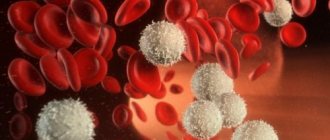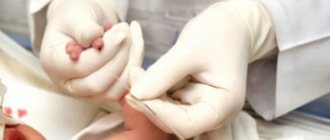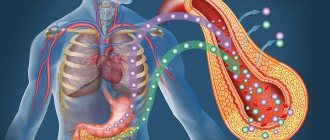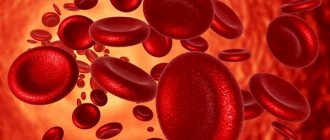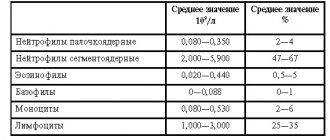- Neutrophils
The norm of leukocytes in the blood of children depends on age. This indicator is determined as part of a general (clinical) blood test, which is carried out during clinical examination and examination of children with various diseases. In addition to the number of leukocytes, the study allows you to determine the percentage of the main subpopulations. In the general blood test form, these cells are designated “WBC” (white blood cells).
In newborns, the number of white blood cells in the blood is much higher than in adults
The main functions of leukocytes are:
- recognition and neutralization of foreign proteins;
- immune protection against infectious agents (bacteria, viruses);
- recycling of dying and damaged body cells.
The highest level of white blood cells is found in newborns, and in children over 13-15 years old it becomes the same as in adults.
The level of leukocytes in the blood almost always changes due to diseases, only in rare cases remaining within normal physiological values.
General information
When answering the question - why are leukocytes needed in a child’s blood, we should turn to their main role. The mechanism of the protective function is realized through their penetration into the intercellular space of the tissue in which a pathological process or inflammatory reaction develops as a result of the penetration of an infectious agent. After which the process of phagocytosis is launched - absorption and subsequent destruction of foreign bodies. The products of phagocytosis are substances, the excessive release of which leads to the development of inflammation, increased body temperature, redness of the lesion and, sometimes, the appearance of pus.
It should be noted that the protective function of leukocytes in a child’s body is realized by the same mechanisms as in adults. A stable deviation of the indicator from the norm, both upward and downward, is a signal about the need for additional examination.
Parents often have a question: what affects the number of leukocytes? First of all, the indicator is influenced by actively progressing infectious infection of the child’s body, autoimmune diseases, as well as oncological pathologies.
Types of leukocytes
Currently, it is customary to distinguish 5 main groups:
- neutrophils - carry out phagocytosis and netosis of small foreign bodies, and also produce antimicrobial peptides;
- lymphocytes – capable of actively synthesizing antibodies, due to which humoral immunity is ensured in humans;
- monocytes are the largest cells capable of destroying large pathogenic microorganisms and viruses;
- eosinophils - penetrate from the bloodstream directly into the site of inflammation, where they neutralize small particles through phagocytosis. In addition, they take part in the allergic reaction;
- basophils - trigger the mechanism of an immediate allergic reaction in the human body.
When conducting a general blood test without a leukocyte formula, only the general level of leukocytes is determined, which does not allow one to estimate the number of all types of cells separately. For the most accurate laboratory test, the leukocyte formula is additionally analyzed. The result of the analysis allows us to differentiate an allergic reaction from an inflammatory one, establish the etiology of inflammation (bacterial, viral), and also determine the severity of the disease.
What diseases do elevated rates indicate?
The level of ESR and eosinophils in children is higher than normal:
- helminthiasis;
- allergies to medications;
- bronchial asthma;
- dermatitis caused by allergies;
- oncological diseases.
The number of neutrophils and the ESR rate are higher than normal:
- meningitis;
- sepsis;
- pneumonia;
- angina;
- pyelonephritis;
- abscess;
- inflammation of the appendix.
An increased number of basophils in the blood is a rare phenomenon that indicates:
- lymphogranulomatosis;
- some types of leukemia;
- thyroid diseases;
- allergic reactions.
The number of monocytes and ESR rate are higher than normal:
- lupus erythematosus;
- pulmonary tuberculosis;
- syphilis;
- brucellosis;
- leukemia
Lymphocytes and ESR can be elevated when:
- measles;
- mononucleosis caused by infection;
- cytomegalovirus;
- flu;
- ARVI;
- whooping cough;
- rubella;
- hepatitis;
- tuberculosis.
Important: upward deviations of lymphocytes from the norm for children under 5 years of age may be physiological. To confirm the possible cause, additional testing is necessary.

The norm of leukocytes in the blood of children in the table
Important: interpretation of any analysis is carried out only by the attending physician.
Reference (normal) values are selected individually for each patient, taking into account age, since the norm of leukocytes in newborns differs from older children. Neglecting the rule for selecting normal values can lead to a false diagnosis, incorrect selection of treatment and complication of the patient’s condition.
The leukocyte formula is deciphered based on the total level of leukocytes. In case of deviation from the reference values of the total number of white cells, a detailed analysis of the number of each type separately is carried out.
The table summarizes the normal values of leukocytes in the blood of a child, taking into account age.
| Child's age | Norm |
| Leukocytes, 109/l | |
| Up to a year | 6-18 |
| From 1 to 2 | 6-17 |
| From 2 to 4 | 5,4-15,7 |
| From 4 to 6 | 4,9-14,6 |
| From 6 to 10 | 4,3-14 |
| From 10 to 16 | 4,5-13,5 |
| Over 16 | 4-11 |
| Neutrophils, 109/l | |
| Up to a year | 1,4-8,7 |
| From 1 to 2 | 1,5-8,5 |
| From 2 to 4 | 1,6-8,7 |
| From 4 to 6 | 1,5-8,2 |
| From 6 to 10 | 1,7-8,5 |
| From 10 to 16 | 1,5-8,3 |
| Over 16 | 1,5-7,5 |
| Lymphocytes, 109/l | |
| Up to a year | 2-10 |
| From 1 to 2 | 2,5-10 |
| From 2 to 4 | 2,3-7,5 |
| From 4 to 6 | 1,3-7,5 |
| From 6 to 10 | 1,5-6,5 |
| From 10 to 16 | 1,3-5,5 |
| Over 16 | 1-5 |
| Monocytes, 109/l | |
| Up to a year | 0,05-1,3 |
| From 1 to 2 | 0,05-0,5 |
| From 2 to 4 | 0,05-0,7 |
| From 4 to 16 | 0,05-0,45 |
| Over 16 | 0,05-0,8 |
| Eosinophils, 109/l | |
| Up to a year | 0,05-0,45 |
| From 1 to 5 | 0,02-0,35 |
| Over 5 | 0,02-0,6 |
| Basophils, 109/l | |
| Any | 0-0,2 |
What does it mean if a child has elevated white blood cells?
Leukocytosis is a high level of white cells in the blood of a child or adult.
Important: a slight deviation from normal values may be the result of daily fluctuations in indicators or improper preparation of the patient for the delivery of biomaterial.
If a child has a consistently high level of leukocytes (up to 11-13*109/l), additional diagnostics should be immediately carried out to identify the cause.
Elevated leukocytes in a child’s blood can be observed when:
- penetration of an infectious agent and the development of a disease of a viral or bacterial nature;
- autoimmune pathologies;
- development of a malignant neoplasm with the spread of metastases.
It should be noted that the state of elevated leukocytes in the blood of newborns requires special attention from doctors. This fact is due to unformed immunity, and the inability of the baby to independently cope with even a small number of opportunistic microorganisms.
What to do and how to treat?
To reduce the level of white blood cells, you first need to find out the cause of their appearance and make a diagnosis. Leukocytosis itself is not a disease, but only a consequence of some cause that can only be determined by a competent specialist.
Treatment may vary depending on the cause:
- non-steroidal anti-inflammatory drugs are prescribed for inflammatory processes;
- antibiotics are used for viral and infectious diseases;
- a diet is prescribed if deviations are caused by malnutrition;
- antimicrobial ointments or spray are used to treat injuries and tissue damage;
- in case of oncology, treatment is selected individually;
- antihistamines relieve the effects of allergic changes;
- if a sharp increase in leukocytes was caused by the drug, reduce its dosage or cancel it.
Physiological leukocytosis does not require treatment. You need to take the test again if there were violations in preparation for it (for example, eating).
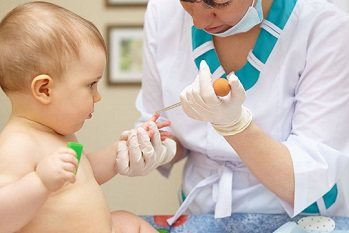
Decoding the leukocyte formula
An upward change in the number of neutrophils indicates the penetration of pathogenic bacteria or microscopic fungi. With severe infection, active production of segmented neutrophils occurs, but they do not have time to mature and enter the bloodstream in an immature form. This condition is a signal about the active work of the body’s defenses to fight infection.
In addition, the number of neutrophils increases with extensive burns, in the acute stage of pancreatitis, as well as with oncological pathology affecting the red bone marrow.
Lymphocytes react to a greater extent to the development of a disease of viral etiology. Thus, when a patient is infected with cytomegalovirus, rubella virus (Rubella virus) or chickenpox virus (Varicella Zoster Virus), an enhanced humoral response of the human immune system is observed. Oncology is another justification for abnormal lymphocyte counts as a result of the analysis. In the case of chronic malignant damage to lymphoid tissue, activation of the protective forces of the immune system is observed, aimed at destroying mutant cells.
Monocytes increase when:
- acute infectious process of viral etiology;
- oncopathology, which affects the bone marrow and lymph nodes, as well as the stomach and ovaries;
- pathologies of connective tissue of various etiologies;
- Besnier-Böck-Schaumann disease primarily affects lung tissue. The peculiarity of the disease is a long asymptomatic course and the impossibility of transmission to other people.
In turn, eosinophils are most sensitive to the penetration of allergens, which can cause the development of allergic shock. More than 1 thousand allergens are known; they can be inhalant, animal, plant, medicinal, mold or food. In addition, segmented eosinophils also respond to parasitic infestation by helminths.
According to statistics, basophils relatively rarely rise to critical values. Possible justifications: severe oncological lesions of the patient with the development of concomitant diseases, as well as allergic shock.
Read further: Leukocyte blood count - decoding in adults and children, norms of indicators
Symptoms of leukocytosis
Leukocytosis is a manifestation of the disease. When the first signs of leukocytosis are detected, it is necessary to conduct extensive laboratory and instrumental diagnostics of the patient in order to establish the main diagnosis. You should pay attention to the main symptoms of leukocytosis in a child:
- weakness and fatigue, which is not a consequence of excessive physical or emotional overload;
- high body temperature;
- sweating;
- bruises and hemorrhages of unknown etiology;
- complaints of pain in certain areas and organs of the body;
- a sharp decrease in appetite and weight loss.
Low white blood cells in a child's blood
Parents are often interested in the answer to the question - what can the result of a blood test indicate, in which the child has low white blood cells (leukopenia). Factors causing the condition of leukopenia include:
- pathologies in the functioning of the bone marrow, as a result of which a sufficient number of blood cells are not formed. Malignant tissue lesions or a lack of vitamins, as well as macro- and microelements, can lead to such malfunctions. In addition, bone marrow destruction is possible due to chemical (drugs) or ionizing effects on humans;
- chronic viral hepatitis;
- leukemia is a malignant lesion of blood cells;
- Rustitsky-Kahler disease – malignant tumors of B-lymphocytes;
- megaloblastic anemia - develops when there is insufficient vitamin B12 in the body, resulting in malfunctions in the bone marrow and nervous system;
- anaphylaxis is an immediate allergic reaction in response to an allergic agent;
- myelodysplastic syndrome, despite the fact that it is extremely rare in children, nevertheless, it is unacceptable to exclude it from the list of possible causes. A characteristic difference is the absence of a typical clinical picture. The condition is characterized by a deficiency of one or more types of blood cells.
What symptoms might bother a child?
Leukocytosis itself does not manifest itself with any symptoms, but the pathological conditions that cause it cause disruptions in the body and are manifested by the following symptoms:
- Stomach ache;
- General weakness;
- Increased sweating;
- Lack of appetite;
- Temperature increase;
- Increased fatigue;
- Dizziness;
- Bleeding.
If a child older than one month has at least one of the listed symptoms, you should definitely consult a doctor and conduct a laboratory blood test.
Preparing for analysis
The cellular composition of blood is the most sensitive to all external factors, therefore, in order to obtain the most reliable results, it is necessary to properly prepare the child for the donation of biomaterial. Preparation rules:
- the biomaterial must be donated strictly on an empty stomach; at least 6 hours must pass between the last meal and the donation procedure;
- It is necessary to give the baby clean, non-carbonated water. This will reduce the risk of hemolysis in vitro, and will also greatly facilitate the collection of biomaterial;
- limit physical and emotional stress, which changes the functioning of the nervous and endocrine systems.
Parents often ask how they take blood for general analysis from children? For a general blood test and for calculating the leukocyte formula, venous blood (collected from the cubital vein in the bend of the elbow, in newborns - from the vein of the head) or capillary blood (taken from the ring finger) is suitable. The number of white blood cells is determined by flow cytometry. The execution time for private and public laboratories does not exceed 1 day.
